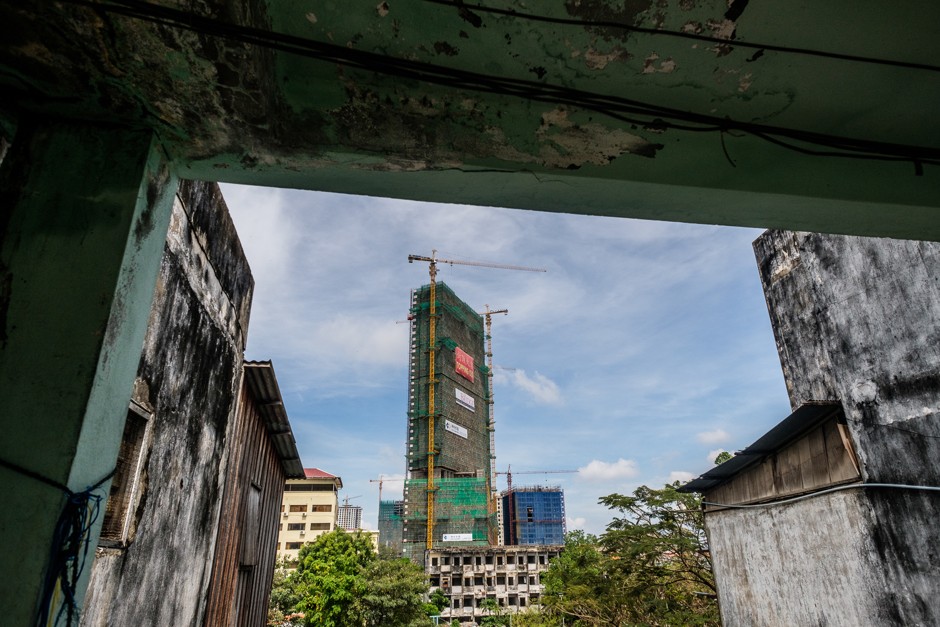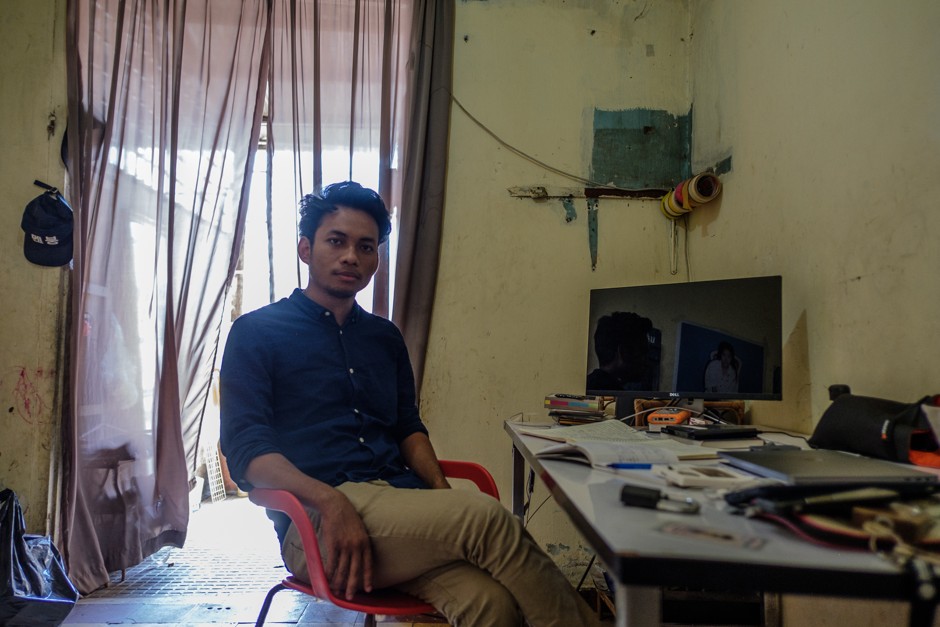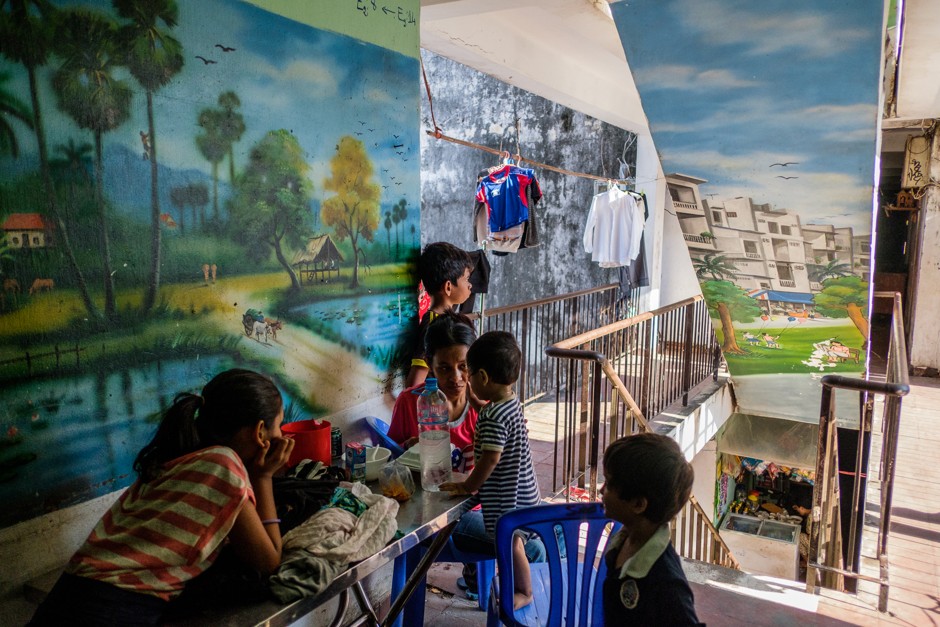The Artists Fighting Displacement in Phnom Penh
Generations have lived and worked in the White Building in Cambodia’s capital. Now, they’re looking for a way to stem the tide of redevelopment that would push them out.
Phnom Penh’s White Building—a fading relic of the 1960s—anchors a three-way intersection in a booming neighborhood, just blocks from a strip of bistros and trendy cocktail bars. In contrast, the four-story apartment building is grimy and crumbling. It seems to burst at the seams.
Today there are few other remnants of its era—considered to be Cambodia’s ‘golden age’—or its architecture. Change is visible all around. Next door, the White Building’s original counterpart has been renovated beyond recognition. Behind it, cranes dot the horizon. Immediately to the east, a skyscraper is going up on a reclaimed spit of land between the apartments and the Mekong River. The large Chinese characters plastered on its side are visible from residents’ windows.
In addition to being an architectural holdover, the building is anomalous in another way: Most of its residents are performers or artists—low-income citizens living affordably as the rents around them skyrocket.
Over the past two decades nearly 30,000 families in Cambodia’s capital have been pushed out of their homes, often to make room for costly development projects. The city government struck one such deal with a construction company for the nine-acre lot behind the White Building in 2005. Within a few years, most of those living there—also artists—had sold off their wooden houses; those who didn’t were evicted with tear gas and water cannons. The land remains empty, but the neighbors haven’t forgotten.

Rumors of an imminent eviction date now pass down the White Building’s open-air hallways. The government announced in October that it had finalized a deal with a Japanese company to tear the landmark down and build a 21-story replacement—at a cost of $70 million—with apartments allotted for all 2,500 current residents. But at a meeting earlier this month, residents made clear to the authorities that they want a buyout commensurate with rising rents, around $70,000 per apartment.
With impending local elections, a decision that quells the rumors seems slow coming. For now, the residents wait.
***
These days, 75-year-old Meas Sokha Mony climbs to her top-floor apartment slowly. The steep stairs hurt her knees. Her living room faces the river, so it’s breezy inside despite the dry-season heat. There are piles of books, family photos, and an old television collecting dust—evidence of nearly four decades spent within the White Building’s walls.
From behind wire-rimmed glasses, Mony recalls moving in with a hint of sadness in her eyes. It was just after 1979, the year the Khmer Rouge regime fell. She had lost her husband and children. Mony—once a classical musician—came to the capital alone for a job as a costumer for a traditional dance troupe. She was one of a few hundred Ministry of Culture and Fine Arts employees offered an apartment in the White Building. Nieces and nephews soon moved in. She made a new life.

It was fitting that artists would revive the complex, says the architect Pen Sereypagna. When the building was completed in 1963, it was part of a planned riverfront community that included a dance conservatory and the national theater. Public housing was a centerpiece of the New Khmer Architecture movement, tracking the city’s growth from a city of 150,000 in 1953 to more than 1 million by 1970. The first White Building tenants were all middle- and lower-class, and agreed to pay rent to the city for 10 years before taking ownership.
Cambodia had been independent from France for a decade, and the populist King Norodom Sihanouk had become the patron of an architecture movement that sought to transform the city, fusing French modernism with Cambodian concepts. It was unlike anything in Southeast Asia, according to historians Helen Ross and Darryl Collins, and the new infrastructure was central to Cambodia’s new image. “By the swinging sixties, Phnom Penh was not only hip—it was the city that most other Southeast Asian nations wished to emulate,” they write in Building Cambodia: New Khmer Architecture.
But the city was emptied in 1975 when the Khmer Rouge rolled in. The White Building remained vacant until Mony and her neighbors arrived. In the years after the war, they stuck together. They built a new community and raised a new generation, many of them artists, too. Then, as now, the hallways were a flurry of activity.
In recent years, Mony says, many of her older friends have moved out of town; for her, the building’s golden age seems to have passed. She is uncertain about the future, and of where she wants to go. “My neighbors have talked about moving. To be honest, I want to stay here. Many of my memories are in this building,” she says. “But nothing lasts long.”
***
As in the 1960s, Cambodia’s capital is now experiencing another period of “urban rupture,” according to Sereypagna. In the first decade of the 2000s, the city more than doubled in size, to 1.3 million. Looking from the street to the skyline, it’s clear that for most residents, development has outpaced income.
The population is young, which is reflected in the hallways of the White Building. Neang Kavich, a 29-year-old filmmaker, is part of the first generation raised there after the fall of the Khmer Rouge. His father—a sculptor—got an apartment in the early 1980s, and Kavich and his siblings were exposed to the arts from an early age. He lived across the hall from a dance studio.
“Every morning when I woke up, I would hear my neighbor practicing his singing voice, and then before lunch I would hear a group of people playing traditional music,” he says. “And then sometimes in the afternoons I would hear people dancing across the hall.”

Kavich began making short films while he was still in college, drawing on his childhood memories and the environment around him. He won awards for a film, loosely based on his parents’ story, which he filmed in a vacant apartment in the building.
The filmmaker, who has a thick mop of black hair and an easy demeanor, is now working on his first feature, tentatively called The White Building. He’s writing the script in a space that he’s rented in the building. He credits much of his success to the opportunities that came from growing up in the community: free English lessons; video workshops from an arts NGO on the second floor; a network of friends in creative fields.
With demolition looming, Kavich acknowledges his film could be one of the building’s last records. “I thought I wanted to make a film about myself. But it goes back to where I’m from, where I’m living,” he says. “It’s now a question I [am asking] myself: how to document this building.”
In an apartment on the second floor, one man has been grappling with that question for the last two years. Chhum Phanith is 26, and his childhood reads like a history of Phnom Penh’s evictions: he grew up land now occupied by the mall down the street and he later moved in with his sister to Dey Krahorm, the community behind the White Building.
Phanith now runs the building’s online archive, which catalogs audio, videos, and photos made about the structure, or inside it. “We wanted to document it, to put it in the public [eye] so that people can understand what it is: what the building looks like, the culture of living here,” he explains.
The project began as a benefit for the community, but it seems to have taken on outsize importance for Phanith, who approaches the part-time gig as a bit of a calling. He plans to work until the building is gone. Of course, there are things that can’t be archived, and others that are hard to track down. Phanith is collecting residents’ family photos, which he plans to scan and add to the collection.
Having witnessed evictions before, he’s not optimistic about what comes next. It’s not just about demolishing the building, he says. “They are tearing down the relationship between the residents, too.”
***
Speaking to residents and other locals, it’s clear that there’s a distinct distrust between the residents and the government, as well as the company preparing to raze homes in favor of a high rise. Residents can’t quite fathom how the plan will fracture their unique community—and one that has weathered the decades so well.
The ministry officials who have come to visit over the last few months have promised the residents temporary relocation to the outskirts of the city, and new apartments in the renovated building within a few years. But the government has not come through on similar commitments to other communities, and residents have taken note. “Maybe the government has a good idea, but it’s still hard for us to believe that,” Kavich says of the plan for new apartments. “Of course we want that, but can you prove it to us?”

Kavich leads me to the top of the White Building, where you can catch the glimpse of the city’s rapid development on all sides. On the way up, we pass a painting that depicts the building as it once was. It’s clean and bright, without the layer of dirt that contradicts its name.
Up on the roof, it’s almost too sunny to stick around. But Kavich has his eyes on the skyline. “You see the buildings going up,” he says. “I used to think when I was younger, ‘Maybe I will live here.’ Now, it’s not so easy.”
“We are worried: where are we going to go? It’s still a question for us to answer. Because now, everything is unsure.”
Vandy Muong contributed reporting to this story.
